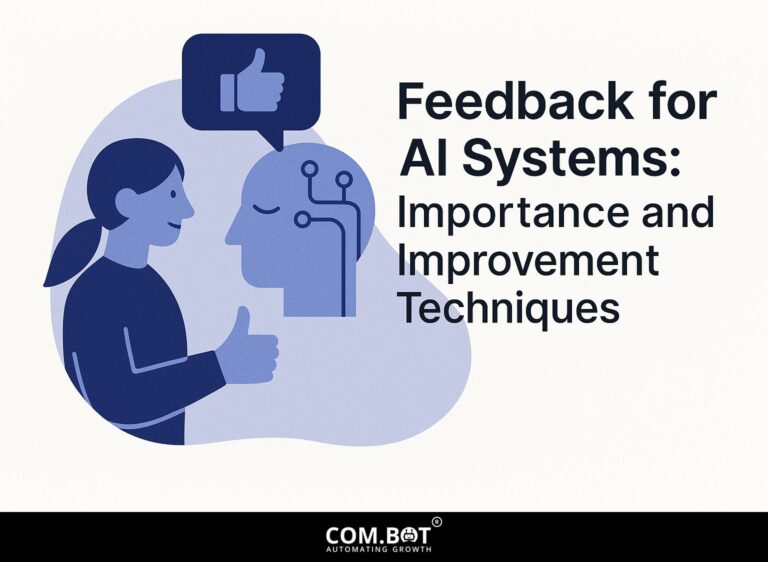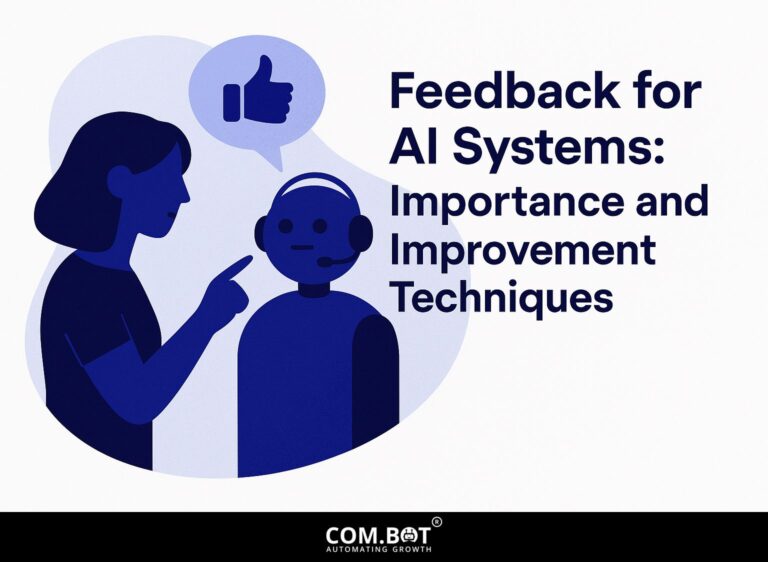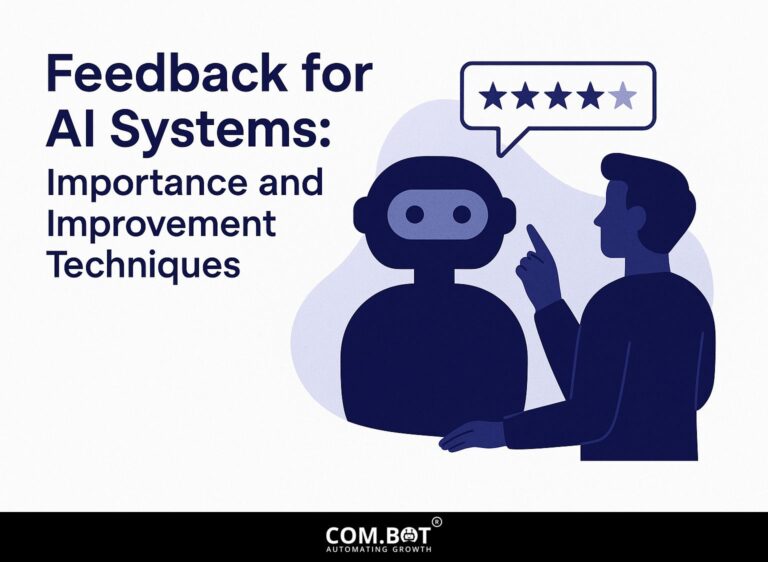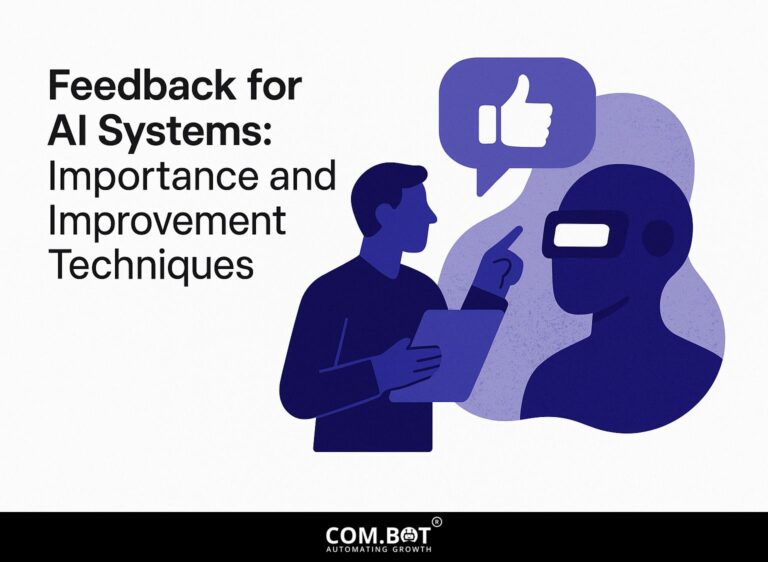Feedback for AI Systems: Importance and Improvement Techniques
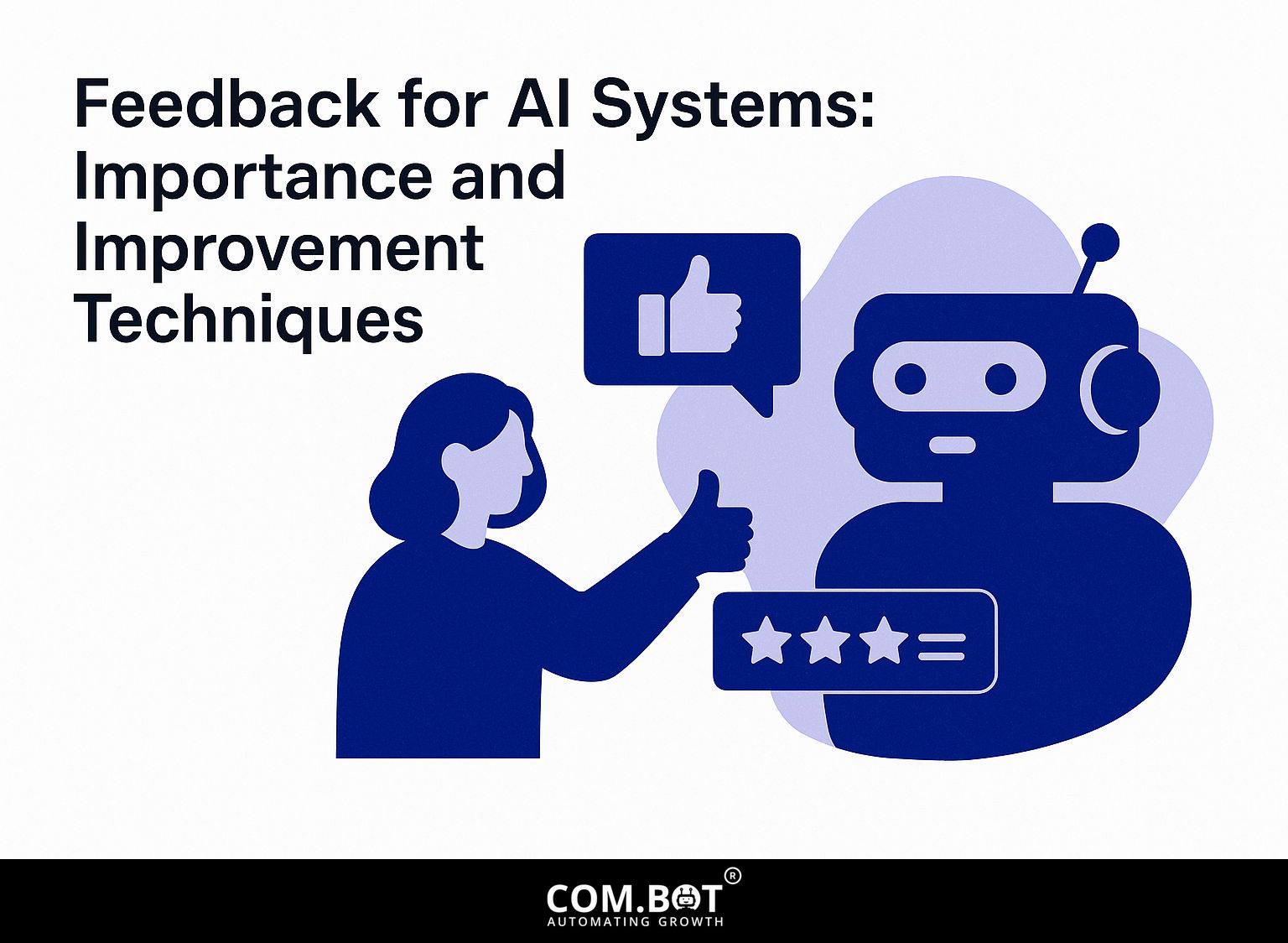
In the fast-changing field of artificial intelligence, human input is important for improving machine learning models. Using knowledge from people, systems can get better through reinforcement learning methods, making them work well and easy to use. Tools like Label Studio make it easier to gather feedback, helping developers improve their AI applications. This article looks at why feedback is important for AI systems and provides practical tips for making the most of it.
Key Takeaways:
- 1 AI Feedback Systems and Cognitive Abilities Impact
- 2 Importance of Feedback for AI Systems
- 3 Types of Feedback Mechanisms
- 4 Techniques for Collecting Feedback
- 5 Implementing Feedback for Improvement
- 6 Challenges in Feedback Integration
- 7 Future Directions in Feedback for AI
- 8 Frequently Asked Questions
- 8.1 What is the importance of feedback for AI systems?
- 8.2 How does feedback help improve AI systems?
- 8.3 What are some techniques for providing feedback to AI systems?
- 8.4 Can feedback be used to address bias in AI systems?
- 8.5 How can incorporating feedback into AI systems benefit businesses?
- 8.6 Is feedback necessary for AI systems to function effectively?
Definition of Feedback
Feedback in AI means giving information to an AI system about how well it is performing, allowing changes and betterment based on how users interact with it.
This feedback can be both qualitative and quantitative.
For instance, qualitative feedback includes user reviews or surveys indicating satisfaction with the AI’s responses. Conversely, quantitative feedback could involve performance metrics like accuracy rates or response times, which help identify areas needing improvement.
Tools such as Google Analytics show how users interact, and platforms like SurveyMonkey collect user feedback directly.
By using these kinds of feedback, developers can keep improving AI algorithms to make user experience better and more successful.
Role of Feedback in AI Development
Feedback is important in AI development, especially in reinforcement learning where systems learn by receiving rewards or punishments based on their actions (explore more about feedback improvement techniques for AI systems).
This repeated process has agents moving through settings, where their choices result in rewards or negative results.
In game AI like AlphaGo, the system improves its strategies by playing many games against itself, changing tactics based on its performance in winning and losing.
Robots in self-driving cars learn from real-world experiences to better steer and make choices.
Each experience helps the AI learn, improving its behavior gradually.
AI Feedback Systems and Cognitive Abilities Impact
AI Feedback Systems and Cognitive Abilities Impact
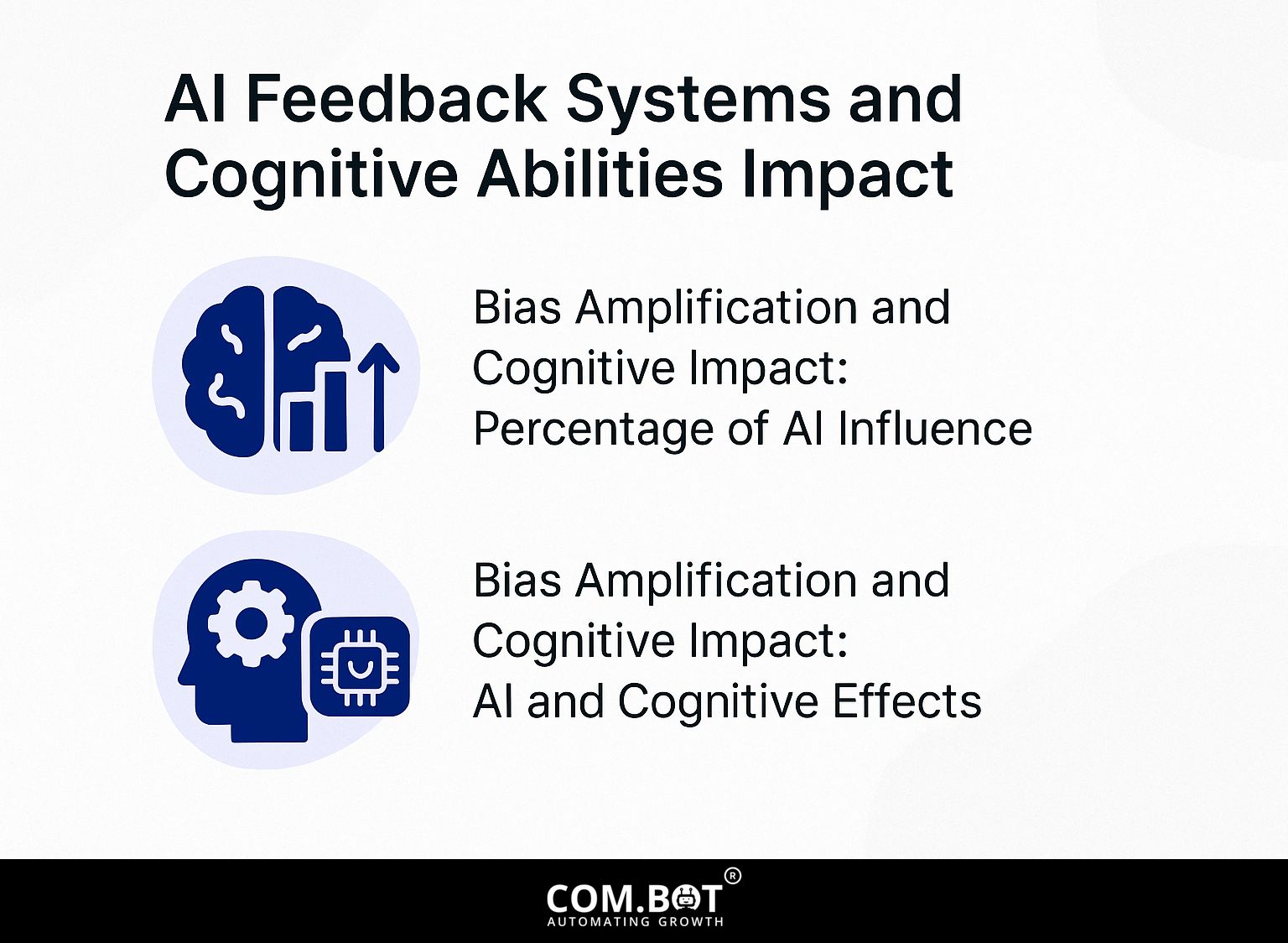
Understanding the impact of AI feedback systems on cognitive abilities is crucial for optimizing machine learning processes. As mentioned in our comprehensive guide on feedback for AI systems, leveraging these techniques can significantly enhance system efficiency and reliability, providing deeper insights into human-machine interactions.
Bias Amplification and Cognitive Impact: Percentage of AI Influence
Bias Amplification and Cognitive Impact: AI and Cognitive Effects
The AI Feedback Systems and Cognitive Abilities Impact The data gives a complete view of how AI interactions affect human biases and thinking abilities. The measurements show how AI systems can worsen current biases and impact important thinking skills, pointing out possible dangers with more use of artificial intelligence.
Bias Amplification and Cognitive Impact metrics show significant rates of influence by AI on human behavior and thought processes. Notably, 65.33% Reports suggest that human-AI interactions can increase human biases. This means that when people use AI systems, there is a chance for current biases to become stronger, which can lead to decisions and views that are not based on facts. Moreover, 56.3% Bias in human classification combined with AI influence highlights the danger of AI systems continuing biased sorting, particularly if these systems are trained using data that reflect societal biases.
Additionally, a 75.0% The decline in critical thinking skills because of AI reliance shows how relying too much on AI affects human thinking and decision-making. This measurement highlights the need to keep and build important thinking skills on our own, separate from AI, to make fair decisions.
- AI and Cognitive Effects reveal further cognitive impacts: With 68.9% People who rely too much on AI might find that their decision-making skills get worse. The information shows that depending on AI can make it harder for humans to make their own decisions. This is compounded by a 75.0% decrease in critical thinking skills, which is consistent across both datasets, underscoring a significant concern about reliance on AI.
- An analytical thinking skill decline of 58.4% points to the diminishing ability to analyze and interpret data independently as individuals rely more on AI systems for these tasks. This decline represents a shift in cognitive skill priorities and development, potentially reducing the quality and depth of human analysis.
The information suggests we should carefully include AI in daily decision-making. While AI offers many benefits, the statistics suggest a cautionary tale about over-reliance on AI, which can weaken essential cognitive skills like critical and analytical thinking. To deal with these effects, it’s necessary to work together so AI systems are built to work with human thinking skills, not to take over. This helps create places where people can continue to use important skills on their own.
Importance of Feedback for AI Systems
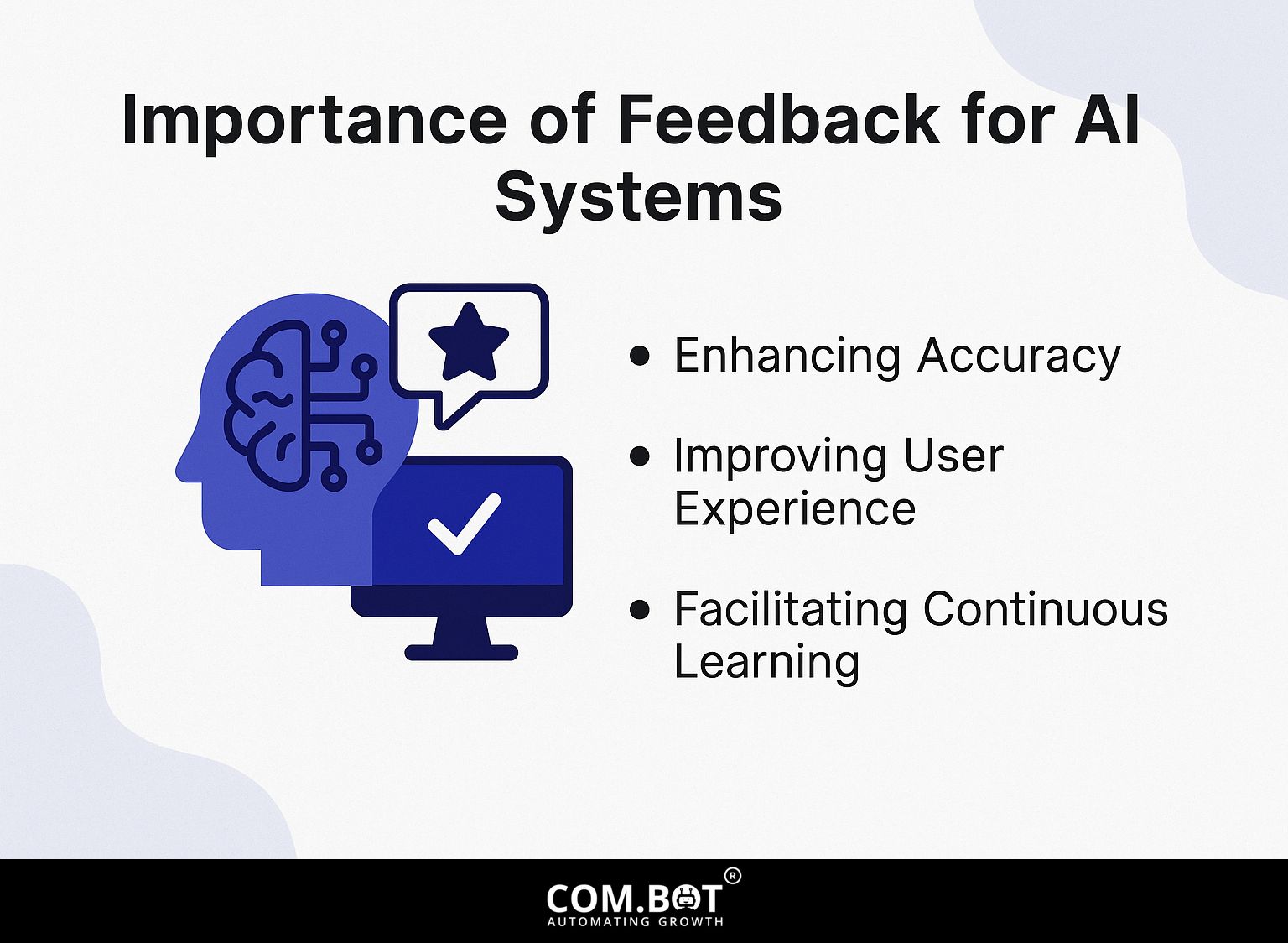
Feedback is important for AI systems because it influences their accuracy, improves user interaction, and supports ongoing learning. For a more in-depth understanding of how feedback mechanisms enhance AI performance, our article on feedback for AI systems covers essential improvement techniques.
Enhancing Accuracy
Using strong feedback methods can increase AI accuracy by up to 40%, as observed in tools like OpenAI’s language models that improve with guided feedback.
For example, when developers collect feedback from users on the results produced, they improve algorithms to understand the meaning more accurately.
Tools like Amazon Mechanical Turk enable real-time human feedback, enhancing learning models significantly.
Running A/B tests allows teams to compare models by watching user reactions, which slowly improves them.
Companies like Google have improved their voice recognition systems by continuously adding user corrections, which have led to better accuracy in voice-command functions.
These strategies improve the accuracy of AI and increase user satisfaction.
Improving User Experience
AI systems that use user feedback can improve user experience by customizing interactions, resulting in a 25% rise in user satisfaction, as demonstrated by Amazon’s recommendation system.
Platforms like Adobe Experience Cloud demonstrate the value of user feedback. By analyzing user behavior, they make features better, such as providing content that matches personal tastes.
In the same way, Slack improves its features based on user feedback, like adding tools that perform tasks automatically since many users requested them.
To use user feedback well, tools like UserVoice or Qualaroo help collect opinions, letting you focus on the changes that matter most to your audience.
Talking directly with users increases happiness and builds loyalty, supporting long-term success.
Facilitating Continuous Learning
Feedback loops play a key role in ongoing learning in AI, allowing systems to change and improve based on user interactions. Google’s search algorithms are a good example of this process.
Machine learning algorithms often use reinforcement learning methods. In these systems, an AI might get positive feedback after correctly guessing what users like, leading it to improve its models.
Recommendation systems on platforms like Netflix or Amazon analyze user ratings and interactions with content to modify upcoming suggestions.
Tools like TensorFlow and PyTorch provide powerful frameworks for creating feedback processes, allowing developers to create custom algorithms that keep learning and improving with real-time data input.
Types of Feedback Mechanisms
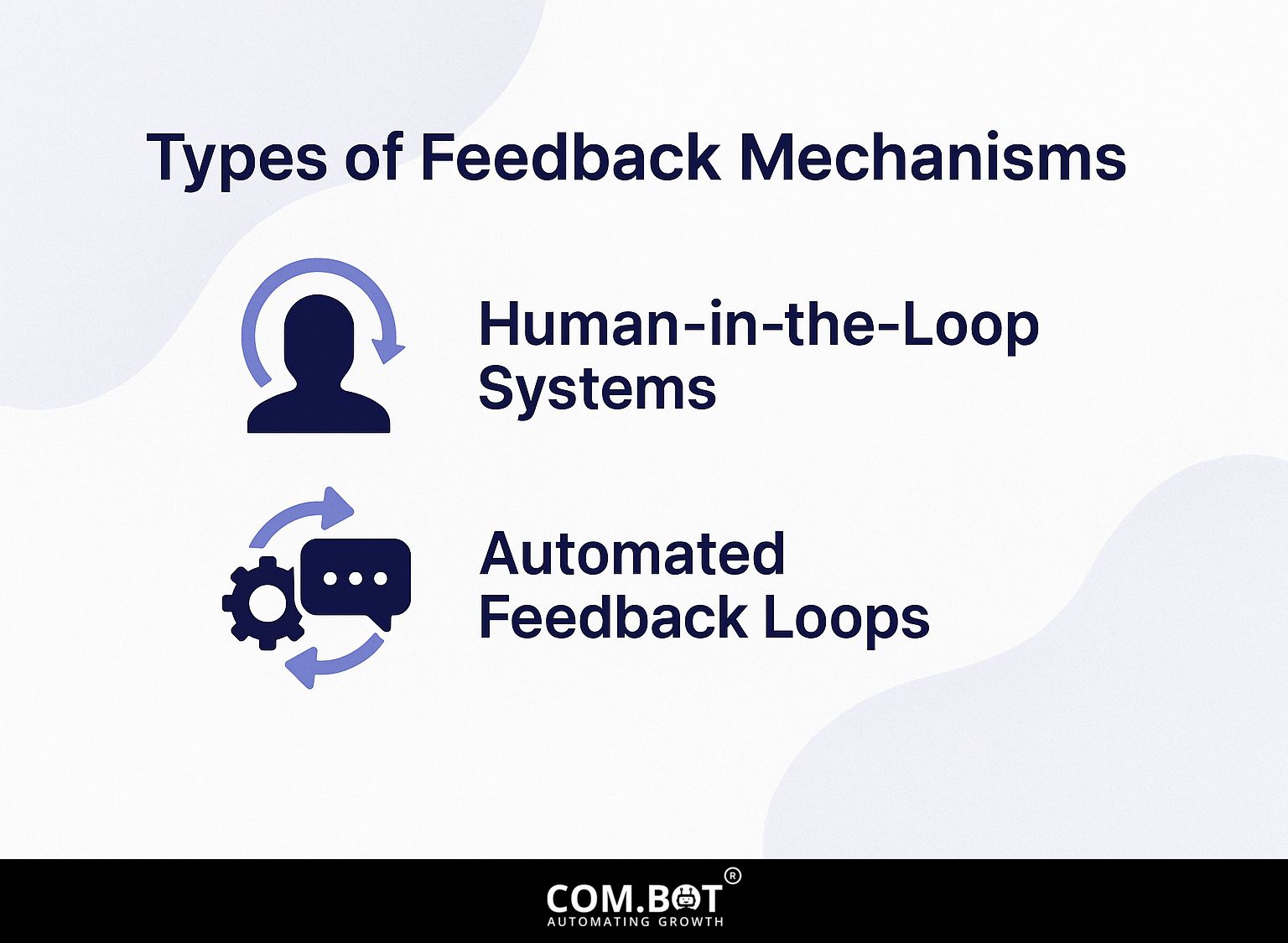
AI systems use different ways to get feedback, combining human input and automatic responses to improve how they work. To better understand these strategies, explore our in-depth guide on feedback for AI systems, which delves into the importance and techniques of enhancing AI performance.
Human-in-the-Loop Systems
Human-in-the-loop systems use direct human feedback in AI decisions to improve the quality of data and make the results more applicable.
One useful method is using tools like Label Studio, which helps with data annotation by letting human reviewers correct and improve AI-generated outputs.
For instance, in a project focused on image classification, you can set up Label Studio to display images for manual review, enabling users to adjust tags or sentiments.
This repeated feedback improves the model’s accuracy over time and promotes clear AI processes. Have people check the model at important times, like during initial training and after updates when the model is active, to make it work as well as possible.
Automated Feedback Loops
Automated feedback loops use performance measurements so AI systems can fix themselves and improve without human help, as shown by reinforcement learning algorithms.
Tools like OpenAI’s Gym and Google’s TensorFlow offer setups for teaching AI through repeated feedback. In reinforcement learning, agents learn from rewards based on their actions, refining their strategies over time.
This self-correcting system is important for activities like robotics or gaming, where adjusting quickly is key. Developers can improve AI performance considerably by using tools like Proximal Policy Optimization (PPO) or Deep Q-Networks (DQN), resulting in more intelligent and efficient systems.
Techniques for Collecting Feedback
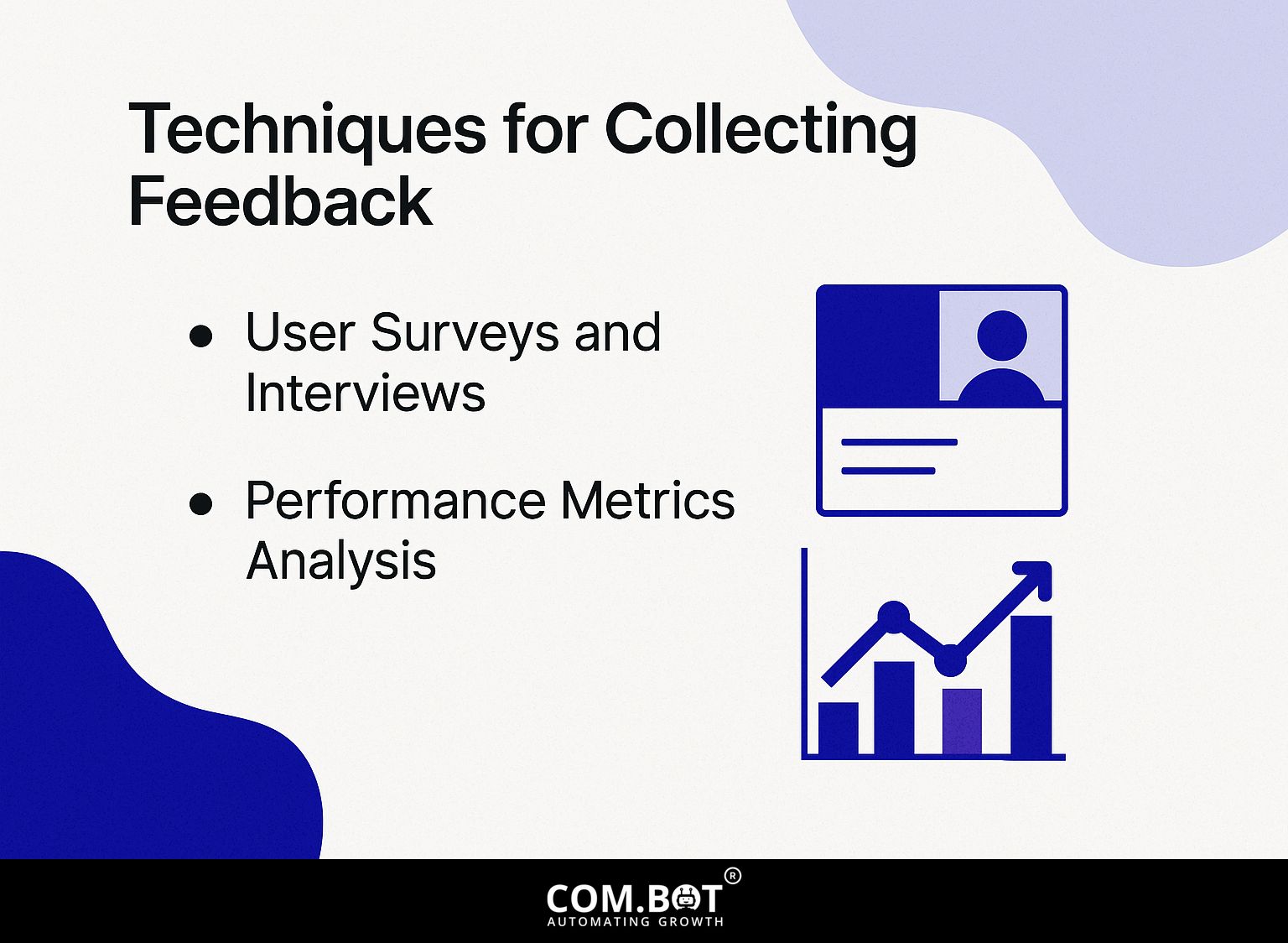
Gathering useful feedback is essential for improving AI, using methods such as user surveys and detailed analysis of performance data.
User Surveys and Interviews
User surveys and interviews can provide useful feedback that improves AI systems, helping developers learn what users need and prefer.
To design effective user surveys, start by defining clear objectives-identify what you hope to learn.
Use tools like SurveyMonkey or Google Forms to create your survey; they provide user-friendly templates and analytics. Focus on essential questions that cover user satisfaction, feature requests, and potential areas for improvement.
A question such as “Which features do you find most useful?” can help with upcoming development. After sharing, examine the responses to find trends and useful information that will help improve your AI.
Performance Metrics Analysis
Checking performance figures provides important information to evaluate the effectiveness of AI systems and improve them.
To select important measures of success, think about three main points:
- accuracy
- exactness
- recall
Accuracy shows how often predictions are right. Precision indicates how many positive predictions are correct. Recall looks at how well the system finds all important cases.
Tools like Google Analytics can track these metrics by integrating them into your AI system’s performance dashboard.
For example, when creating a spam detection tool, high accuracy means less chance of misidentifying non-spam as spam, while recall makes sure that most spam messages are identified.
Focus on the metric that aligns best with your project’s goals.
Implementing Feedback for Improvement
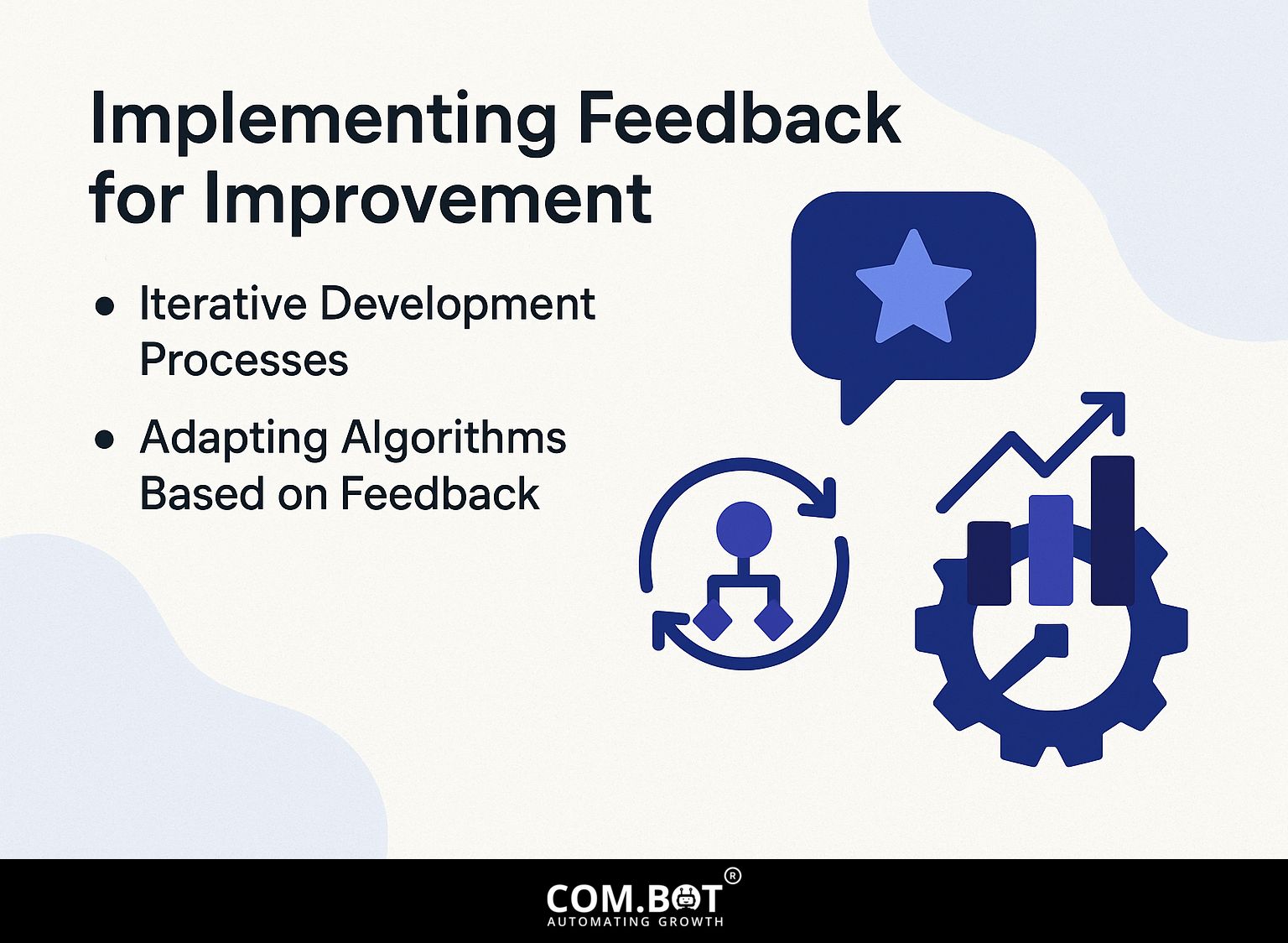
To make AI systems work well, it’s important to use feedback from users and update algorithms regularly.
Iterative Development Processes
Repeated development steps let AI systems improve over time with feedback, as shown by Agile methods in tech firms.
Companies like Spotify have effectively used a method where they break projects into small parts called sprints for testing. Each sprint targets a specific feature, letting teams quickly collect user feedback.
For example, when introducing a new playlist algorithm, Spotify’s team released a version, collected feedback from listeners, and made changes within weeks.
Quick feedback makes users happy and encourages new ideas, showing that repeating processes can greatly improve results in AI projects.
Adapting Algorithms Based on Feedback
Changing algorithms based on feedback allows AI systems to improve how they work, which affects how well they perform and how happy users are.
For example, Netflix uses the data on what users watch to improve its suggestion system. If a subscriber consistently watches thrillers, the algorithm adjusts, suggesting more titles in that genre.
Google Search looks at how often people click on links to make search results better. If a lot of people click on certain links, those websites will appear higher in later searches.
By using feedback loops, both platforms improve user involvement, showing the effectiveness of changing algorithms in real-time learning and improving performance.
Challenges in Feedback Integration
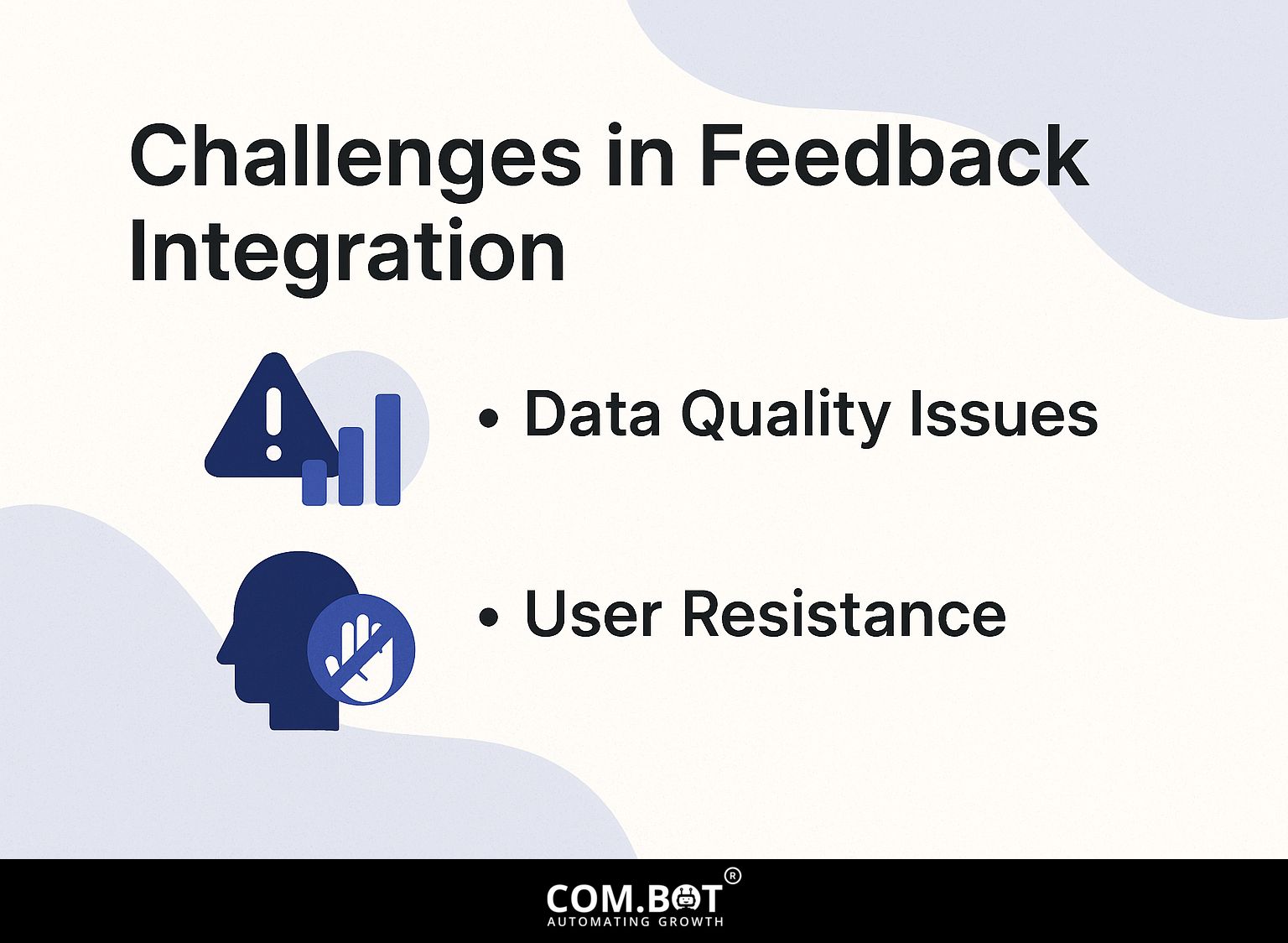
Adding feedback to AI systems involves some difficulties.
Problems with data quality and pushback from users can prevent these systems from working well.
Data Quality Issues
Problems with data quality, like mistakes and biases, can greatly affect the usefulness of feedback in AI training, resulting in outcomes that are not dependable.
To improve data integrity, implement consensus labeling where multiple annotators review and vote on the accuracy of data points.
For instance, if a dataset contains labeled images, engage three independent reviewers to assess each label. Use tools like Amazon Mechanical Turk or Figure Eight to help with this process and provide a range of opinions.
Regularly audit your data for inconsistencies, employing statistical methods to track anomalies. Addressing these problems at the start ensures data is reliable, resulting in accurate AI outcomes.
User Resistance
User reluctance can slow down feedback gathering, often due to worries about privacy and how AI systems use data.
Organizations can do a few things to solve this problem.
- Clearly communicate how data will be used, assuring users that their privacy is a top priority.
- Implement transparent consent forms, detailing what data is collected and the benefits of providing feedback.
- Consider using gamification techniques by rewarding users for participating in feedback loops, such as offering discounts or access to premium features.
- Make feedback platforms easy to use so that people are more likely to take part. The process should be smooth and interesting.
Future Directions in Feedback for AI
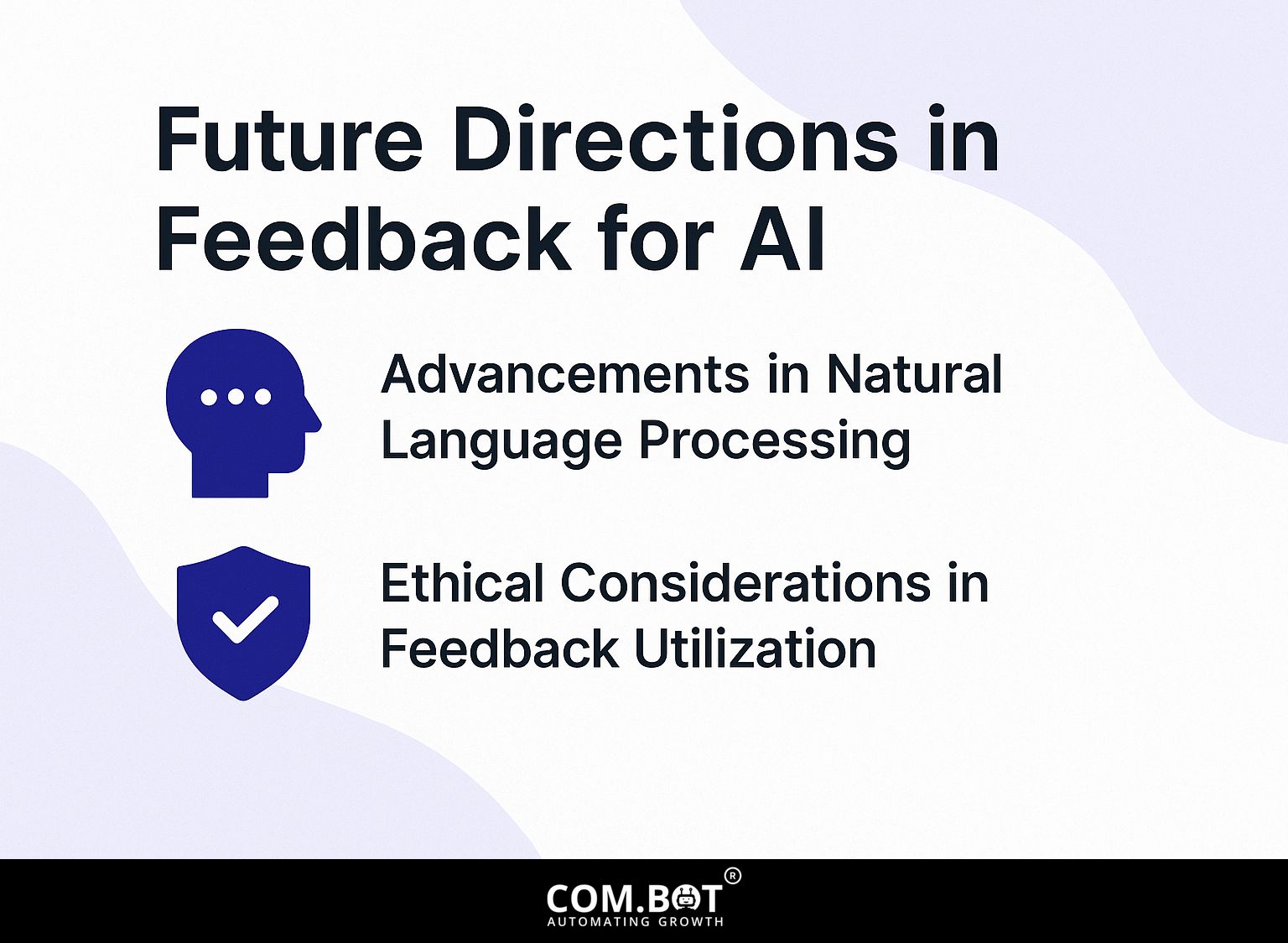
Upcoming changes in how AI systems handle feedback are expected due to progress in Natural Language Processing and increased focus on ethics. For those interested in exploring effective strategies, discover our complete strategy for improving feedback mechanisms in AI systems.
Advancements in Natural Language Processing
Advancements in Natural Language Processing are enhancing feedback systems, enabling more thorough user interactions and improving AI training models.
Tools like Qualtrics and Medallia now use NLP to study open-ended replies instantly, finding emotions and main ideas. This technology helps companies quickly address user issues, improving satisfaction.
Platforms like SurveyMonkey use tools that analyze language to organize user feedback, helping to present customer opinions in a clear way. These new methods are changing how companies manage feedback during product development. They convert user input into helpful information that guides wise decisions and upgrades.
Ethical Considerations in Feedback Utilization
Ethical considerations surrounding feedback utilization are critical, as biases in AI can be reinforced through flawed feedback mechanisms, necessitating careful oversight.
To use feedback ethically in AI systems, organizations should follow certain effective practices.
- Begin by forming multiple feedback groups to collect a range of opinions, helping to identify any biases.
- Next, regularly audit AI models for skewed outcomes by analyzing performance metrics across different demographic groups.
- It’s important to clearly show where feedback comes from and how decisions are made.
- Support continuous learning where attendees can discuss the AI’s effectiveness and suggest improvements to make it fairer and more balanced over time.
Frequently Asked Questions
What is the importance of feedback for AI systems?
Feedback for AI systems is essential to maintain their accuracy and functionality. By receiving feedback, these systems can continuously learn and improve, resulting in better performance and user satisfaction.
How does feedback help improve AI systems?
Feedback allows AI systems to identify and correct errors, as well as make adjustments based on user preferences. Continuous improvements make AI systems more accurate and efficient.
What are some techniques for providing feedback to AI systems?
Some techniques for providing feedback to AI systems include rating systems, surveys, user testing, and natural language feedback. These methods collect numbers and descriptions, providing a full overview of system performance.
Can feedback be used to address bias in AI systems?
Yes, feedback can help identify and address bias in AI systems. By getting input from different users, AI systems can be regularly checked and changed to make sure the results are fair and free of bias.
How can incorporating feedback into AI systems benefit businesses?
Using feedback to improve AI systems can help businesses by making their systems more accurate and effective, which supports better decisions and happier customers. This can also lead to cost savings and a competitive advantage in the market.
Is feedback necessary for AI systems to function effectively?
Yes, feedback is essential for AI systems to function effectively. Feedback allows these systems to learn and get better, preventing mistakes and poor results.
